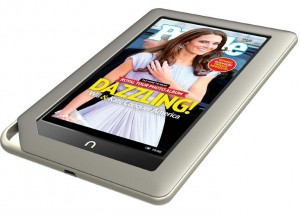 The Nook Tablet looks pretty much the same as the Nook Color. The black border has been grayed out, but that is about it. When comparing the Kindle Fire to the Nook Tablet, the Kindle Fire appears to be designed for monks – it is so plain. There is the hook on the side that mystifies some, but you should grab hold of it if the tablet starts to fly off your lap when someone bumps you. Or you could tether it to your belt.
The Nook Tablet looks pretty much the same as the Nook Color. The black border has been grayed out, but that is about it. When comparing the Kindle Fire to the Nook Tablet, the Kindle Fire appears to be designed for monks – it is so plain. There is the hook on the side that mystifies some, but you should grab hold of it if the tablet starts to fly off your lap when someone bumps you. Or you could tether it to your belt.
The Tablet is much lighter than the Color, but it is a better feeling, without cheaping the touch. While the thickness is the same, the weight shed was 0.11 pounds. It is also 0.03 pounds lighter than the Fire. The Fire is smaller, though. Despite the size, though, the Tablet’s rubber backing made for a comfortable ride.
The Fire is deficient in physical buttons, lacking both a volume and home. The Tablet, though, is loaded with physical presence. The power is on the left edge, the volume on the right. A MicroUSB adorns the bottom edge and a 3.5mm headphone jack the top. On the flip side, next to the hook, is a cover that hides the microSD card slot, supporting up to 32G cards. The lack of a camera gave the Tablet its sweet price at $250.
As for the displays, the Tablet has an edge on the Fire. The colors are sharper and deeper, but the viewing angle is also wider. The Tablet, with its 1024×600 7-inch IPS screen, reaches a 90-degree viewing angle, that the Fire lacks. The Tablet’s display is quite sensitive to both taps and swipes.
As for the speakers, do not expect to play music on the Tablet. The quality is that of a thin tincan, even when the volume is maxed out. However, with the Read and Play children’s books the sound was quite good. The Fire has a similar problem. The winner in speakers is still iPad.
 Even in the software department, the Tablet has retained much the same that the Color had. Android 2.3 is loaded. However, the Tablet fails to be a tablet when examining the browsing experience. The browser is limited to a single area of the Tablet, accessed by single-clicking the Home button. The lack of tabs in the browser also cripples the browsing experience. The Fire, on the other hand, has tabs. The Tablet’s browser performance was quick, but not quite on par with either iPad or Galaxy Tab 7.0 Plus.
Even in the software department, the Tablet has retained much the same that the Color had. Android 2.3 is loaded. However, the Tablet fails to be a tablet when examining the browsing experience. The browser is limited to a single area of the Tablet, accessed by single-clicking the Home button. The lack of tabs in the browser also cripples the browsing experience. The Fire, on the other hand, has tabs. The Tablet’s browser performance was quick, but not quite on par with either iPad or Galaxy Tab 7.0 Plus.
The battery life is between 7-9 hours. The dual-core TI OMAP CPU and 1G RAM produce a smoother experience over the Color, but it still lacks a smooth scrolling in the browser. Also, the microUSB takes a regular cable to connect to the computer, but a proprietary one to recharge the Tablet.
B&N does not offer the apps up front that Amazon does and the Fire is $50 less than the Tablet. You do get Netflix and Pandora subscriptions available on the Tablet, though.





